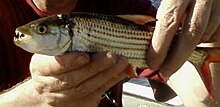Hydrocynus vittatus
| Hydrocynus vittatus | |
|---|---|

| |
| Small H. vittatus specimen from the upper Zambezi | |
| Scientific classification | |
| Kingdom: | |
| Phylum: | |
| Class: | |
| Order: | |
| Family: | |
| Genus: | |
| Species: | H. vittatus
|
| Binomial name | |
| Hydrocynus vittatus (Castelnau, 1861)
| |
Hydrocynus vittatus, the African tigerfish, tiervis or ndweshi[2] is a predatory freshwater fish distributed throughout much of Africa. It has been observed leaping out of the water and catching swallows (Hirundo rustica) in flight.[3][4]
Appearance
The African tigerfish is overall silvery in colour, with thin black stripes running horizontally. It has an elongated body and a red, forked caudal fin with a black edge. Its head is large, as well as its teeth, of which there are eight per jaw. Males are larger and more full-bodied than females. [5] It grows to a length of 105 centimetres (41 in) SL.[6]
Distribution
This species' distribution covers the Niger/Bénoué, Ouémé River, Senegal River, Nile, Omo River, Congo River, Lufira, Lualaba River, Luapula, Zambezi, Limpopo River, Rovuma, Shire River and Wami River; as well as Lakes - Lake Bangweulu, Moéro, Tanganyika, Upemba, Rukwa and Malagarazi. It is also found in the Okavango Basin and lower reaches of coastal systems south to the Pongola River and in man-made Lake Kariba and Schroda Dam.[7]
Habitat and ecology
A demersal, migratory freshwater species, Hydrocynus vittatus prefers warm, well-oxygenated water, mainly in larger rivers and lakes. The smaller individuals form roving schools of like-sized fish; aptly described as fierce and voracious but very large specimens may be solitary. It preys on most abundant fish species available, but species of the genera Brycinus, Micralestes, Barbus, and Limnothrissa are favoured prey. Breeding occurs on a few days each year, when the initial rains have swollen the rivers and streams, normally in December and January when a spawning migration is undertaken upstream into rivers and smaller streams. The females spawn a great number of eggs in very shallow water, among the stems submerged and partly submerged vegetation where the fry stay until the receding of the flood water makes them return to the main channels.[1]
A highly unusual feeding behavior has been seen in the Schroda Dam population of Hydrocynus vittatus. The fish jump out of the water and catch barn swallows (Hirundo rustica) on the wing as they fly near the surface of the lake feeding on insects. The researchers observed an average success rate of 25% for predation attempts, with as many as twenty birds caught per day over a relatively small lake (4.1 x 106 m3). This is the only documented instance of a freshwater fish exhibiting this behavior.[3]
Population and conservation status
This species is common and widespread over most of its range. In the most studied population, that of Lake Kariba on the Middle Zambezi River, the population fluctuated markedly, apparently in direct relation to the abundance of the introduced clupeid Limnothrissa miodon which forms a major part of its diet. There is a commercial fishery in Lake Rukwa, where it forms about 3.9% of the yield.
Hydrocynus vittatus have declined in some river systems in southern Africa as a result of pollution, water abstraction and obstructions by dams and weirs that prevent migration. It is locally threatened by unregulated gillnet fisheries. In east Africa, threats to populations include overfishing, reductions in water quality due to agricultural activities and deforestation, and pesticide pollution.[1]
References
- ^ a b c Template:IUCN
- ^ Common Names List - Hydrocynus vittatus
- ^ a b O'Brian, G.C. (19 DEC 2013). "First observation of African tigerfish Hydrocynus vittatus predating on barn swallows Hirundo rustica in flight". Journal of Fish Biology. 84 (1): 263–266. doi:10.1111/jfb.12278. Retrieved 10 January 2014.
{{cite journal}}: Check date values in:|date=(help); Unknown parameter|coauthors=ignored (|author=suggested) (help) Includes a video. - ^ Ella Davies (13 January 2014). "African tigerfish catch swallows in flight". Nature News. BBC. Retrieved 13 January 2014. Includes a video.
- ^ http://animal-world.com/encyclo/fresh/characins/AfricanTigerFish.php
- ^ Froese, Rainer; Pauly, Daniel (eds.). "Hydrocynus vittatus". FishBase. December 2013 version.
- ^ Hydrocynus vittatus, Tiger fish : fisheries, gamefish
External links
- Phillipson, David W. 1985. Mosi-oa-Tunya A Handbook to the Victoria Falls Region Long man Zimbabwe ISBN 0-0546-8657

